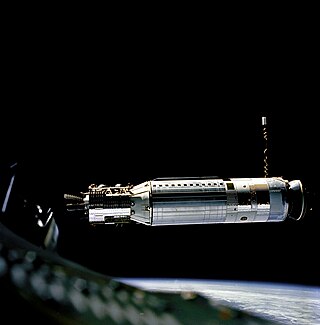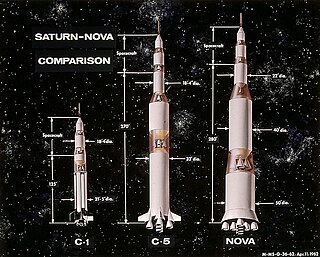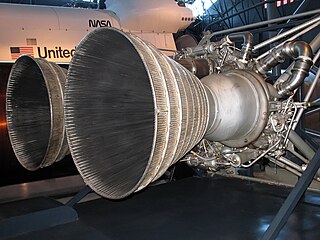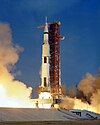
The Centaur is a family of rocket propelled upper stages that has been in use since 1962. It is currently produced by U.S. launch service provider United Launch Alliance, with one main active version and one version under development. The 3.05 m (10.0 ft) diameter Common Centaur/Centaur III flies as the upper stage of the Atlas V launch vehicle, and the 5.4 m (18 ft) diameter Centaur V is being developed as the upper stage of ULA's new Vulcan rocket. Centaur was the first rocket stage to use liquid hydrogen (LH2) and liquid oxygen (LOX) propellants, a high-energy combination that is ideal for upper stages but has significant handling difficulties.

The S-IVB was the third stage on the Saturn V and second stage on the Saturn IB launch vehicles. Built by the Douglas Aircraft Company, it had one J-2 rocket engine. For lunar missions it was fired twice: first for Earth orbit insertion after second stage cutoff, and then for translunar injection (TLI).

The RM-81 Agena was an American rocket upper stage and satellite bus which was developed by Lockheed Corporation initially for the canceled WS-117L reconnaissance satellite program. Following the split-up of WS-117L into SAMOS and Corona for image intelligence, and MIDAS for early warning, the Agena was later used as an upper stage, and an integrated component, for several programs, including Corona reconnaissance satellites and the Agena Target Vehicle used to demonstrate rendezvous and docking during Project Gemini. It was used as an upper stage on the Atlas, Thor, Thorad and Titan IIIB rockets, and considered for others including the Space Shuttle and Atlas V. A total of 365 Agena rockets were launched between February 28, 1959 and February 1987. Only 33 Agenas carried NASA payloads and the vast majority were for DoD programs.

The Saturn family of American rockets was developed by a team of former German rocket engineers and scientists led by Wernher von Braun to launch heavy payloads to Earth orbit and beyond. The Saturn family used liquid hydrogen as fuel in the upper stages. Originally proposed as a military satellite launcher, they were adopted as the launch vehicles for the Apollo Moon program. Three versions were built and flown: the medium-lift Saturn I, the heavy-lift Saturn IB, and the super heavy-lift Saturn V.

Saturn-Apollo 5 (SA-5) was the first launch of the Block II Saturn I rocket and was part of the Apollo program. In 1963, President Kennedy identified this launch as the one which would place US lift capability ahead of the Soviets, after being behind for more than six years since Sputnik.
The Saturn I was a rocket designed as the United States' first medium lift launch vehicle for up to 20,000-pound (9,100 kg) low Earth orbit payloads. The rocket's first stage was built as a cluster of propellant tanks engineered from older rocket tank designs, leading critics to jokingly refer to it as "Cluster's Last Stand". Its development was taken over from the Advanced Research Projects Agency in 1958 by the newly formed civilian NASA. Its design proved sound and flexible. It was successful in initiating the development of liquid hydrogen-fueled rocket propulsion, launching the Pegasus satellites, and flight verification of the Apollo command and service module launch phase aerodynamics. Ten Saturn I rockets were flown before it was replaced by the heavy lift derivative Saturn IB, which used a larger, higher total impulse second stage and an improved guidance and control system. It also led the way to development of the super-heavy lift Saturn V which carried the first men to landings on the Moon in the Apollo program.

Nova was a series of NASA rocket designs that were proposed both before and after the Saturn V rocket used in the Apollo program. Nova was NASA's first large launcher proposed in 1958, for missions similar to what Saturn V was subsequently used for. The Nova and Saturn V designs closely mirrored each other in basic concept, power, size, and function. Differences were minor but practical, and the Saturn was ultimately selected for the Apollo program, largely because it would reuse existing facilities to a greater extent and could make it to the pad somewhat earlier.

The RL10 is a liquid-fuel cryogenic rocket engine built in the United States by Aerojet Rocketdyne that burns cryogenic liquid hydrogen and liquid oxygen propellants. Modern versions produce up to 110 kN (24,729 lbf) of thrust per engine in vacuum. Three RL10 versions are in production for the Centaur upper stage of the Atlas V and the DCSS of the Delta IV. Three more versions are in development for the Exploration Upper Stage of the Space Launch System and the Centaur V of the Vulcan rocket.

Titan IV was a family of heavy-lift space launch vehicles developed by Martin Marietta and operated by the United States Air Force from 1989 to 2005. Launches were conducted from Cape Canaveral Air Force Station, Florida and Vandenberg Air Force Base, California.
The Saturn Vehicle Evaluation Committee, better known as the Silverstein Committee, was a US government commission assembled in 1959 to recommend specific directions that NASA could take with the Saturn rocket program. The committee was chaired by Abe Silverstein, a long-time NASA engineer, with the express intent of selecting upper stages for the Saturn after a disagreement broke out between the Air Force and Army over its development. During the meetings the Committee members outlined a number of different potential designs, including the low-risk solution von Braun was developing with existing ICBM airframes, as well as versions using entirely new upper stages developed to take full advantage of the booster stage. The advantages of using new uppers were so great that the committee won over an initially skeptical von Braun, and the future of the Saturn program changed forever.

The Atlas-Centaur was a United States expendable launch vehicle derived from the SM-65 Atlas D missile. The vehicle featured a Centaur upper stage, the first such stage to use high-performance liquid hydrogen as fuel. Launches were conducted from Launch Complex 36 at the Cape Canaveral Air Force Station (CCAFS) in Florida. After a strenuous flight test program, Atlas-Centaur went on to launch several crucial spaceflight missions for the United States, including Surveyor 1, Mariner 4, and Pioneer 10/11. The vehicle would be continuously developed and improved into the 1990s, with the last direct descendant being the highly successful Atlas II.

A modular rocket is a kind of multistage rocket which has components that can interchanged for different missions. Several such rockets use similar concepts such as unified modules to minimize expenses on manufacturing, transportation and for optimization of support infrastructure for flight preparations.
The Saturn C-2 was the second rocket in the Saturn C series studied from 1959 to 1962. The design was for a four-stage launch vehicle that could launch 21,500 kg (47,300 lb) to low Earth orbit and send 6,800 kg (14,900 lb) to the Moon via Trans-Lunar Injection.
The C-2 design concept was for a proposed crewed circumlunar flight and the Earth orbit rendezvous (EOR) missions. It was initially considered for the Apollo lunar landing at the earliest possible date (1967).
Saturn A-1, studied in 1959, was projected to be the first version of Saturn I and was to be used if necessary before the S-IV liquid hydrogen second stage became available. The first stage, proposed for the Juno V rocket, but finally used for the first Saturn rocket, would propel the Saturn A-1 into space, with the first stage of a Titan I missile continuing the flight and finally, a Centaur C high-energy double-engine third stage could perform a small burn to send a payload into its final orbit, or it can perform a big burn to take a payload out of Earth orbit to other planets. This rocket never flew, but all stages of the Saturn A-1 were used on different launch vehicles. Today, they are all retired.

Saturn V is a retired American super heavy-lift launch vehicle developed by NASA under the Apollo program for human exploration of the Moon. The rocket was human-rated, had three stages, and was powered with liquid fuel. Flown from 1967 to 1973, it was used for nine crewed flights to the Moon, and to launch Skylab, the first American space station.
Advanced Gemini is a number of proposals that would have extended the Gemini program by the addition of various missions, including crewed low Earth orbit, circumlunar and lunar landing missions. Gemini was the second crewed spaceflight program operated by NASA, and consisted of a two-seat spacecraft capable of maneuvering in orbit, docking with uncrewed spacecraft such as Agena Target Vehicles, and allowing the crew to perform tethered extra-vehicular activities.

The LR87 was an American liquid-propellant rocket engine used on the first stages of Titan intercontinental ballistic missiles and launch vehicles. Composed of twin motors with separate combustion chambers and turbopump machinery, it is considered a single unit and was never flown as a single combustion chamber engine or designed for this. The LR87 first flew in 1959.

Vulcan Centaur is a two-stage-to-orbit, heavy-lift launch vehicle under development by United Launch Alliance (ULA) since 2014. It is principally designed to meet launch demands for the U.S. government's National Security Space Launch (NSSL) program for use by the United States Space Force and U.S. intelligence agencies for national security satellite launches. It will replace both of ULA's existing launchers in this role, as these launchers are retiring. Vulcan Centaur will also be used for commercial launches, including an order for 38 launches from Kuiper Systems.

Shuttle-Centaur was a version of the Centaur upper stage rocket designed to be carried aloft inside the Space Shuttle and used to launch satellites into high Earth orbits or probes into deep space. Two variants were developed: Centaur G-Prime, which was planned to launch the Galileo and Ulysses robotic probes to Jupiter, and Centaur G, a shortened version planned for use with United States Department of Defense Milstar satellites and the Magellan Venus probe. The powerful Centaur upper stage allowed for heavier deep space probes, and for them to reach Jupiter sooner, prolonging the operational life of the spacecraft. However, neither variant ever flew on a Shuttle. Support for the project came from the United States Air Force (USAF) and the National Reconnaissance Office, which asserted that its classified satellites required the power of Centaur. The USAF agreed to pay half the design and development costs of Centaur G, and the National Aeronautics and Space Administration (NASA) paid the other half.

Andrew John Stofan is an American engineer. He worked for the National Aeronautics and Space Administration (NASA) at the Lewis Research Center. In the 1960s he played an important role in the development of the Centaur upper stage rocket, which pioneered the use of liquid hydrogen as a propellant. In the 1970s he managed the Atlas-Centaur and Titan-Centaur Project Offices, and oversaw the launch of the Pioneer 10 and Pioneer 11 probes to Jupiter and Saturn, the Viking missions to Mars, Helios probes to the Sun, and the Voyager probes to Jupiter and the outer planets. He was director of the Lewis Research Center from 1982 to 1986.















